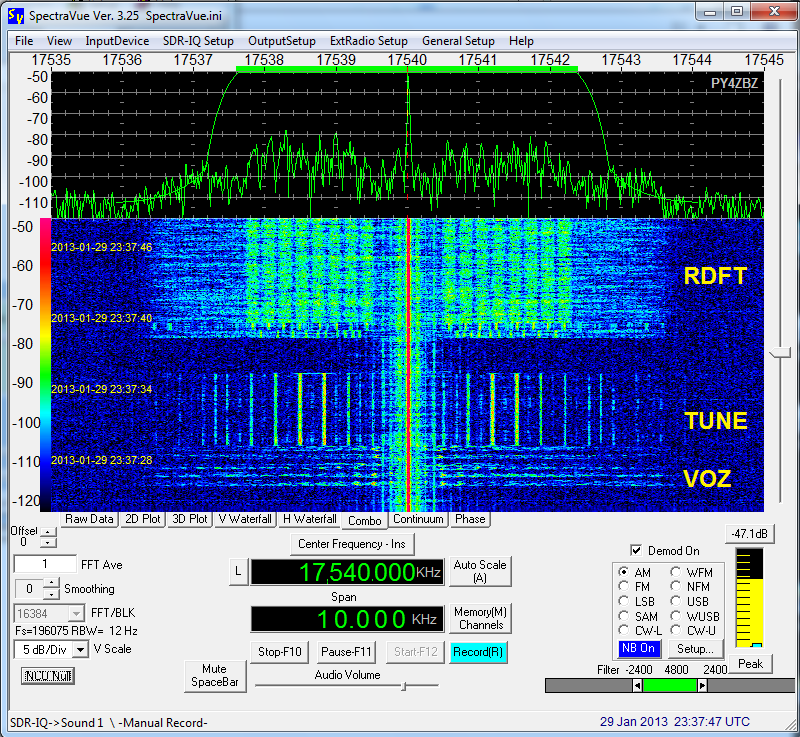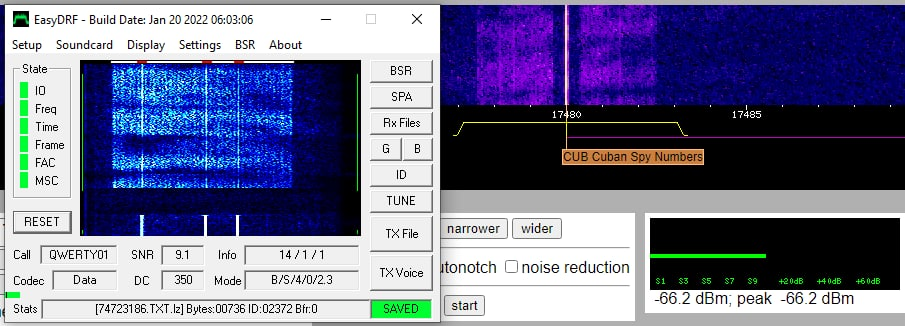
Cuban Numbers Station
By PY4ZBZ on 24-01-2013 rev. 20-05-2022 Em português aqui
What is a Numbers station ?
Encrypted content of a TXT message transmitted in RDFT
Format of a typical transmission
Reception via WebSDR and with SDR Console on WWW
As of 2022-05-11, the Cuban numbers station began broadcasting in DRM mode.
On 24-01-2013, on 16.180 MHz, between 21:35 and 21:50 UTC, and to my great surprise, I heard an AM broadcast from a numbers station, that used the program of my authorship, with the old RDFT system (Redundant Digital File Transfer) : DIGTRX !
The group Enigma2000 classifies this transmission as HM01, why it is a Hybrid Mixed of V02a (voice) and SK01 (RDFT)
This screen shot is from DIGTRX receiving this station, in RDFT mode, on 1/24/2013, and decoding the file 22235071.TXT:

Spectrogram of the modulating signal from the Cuban numbers station. Each digital RDFT transmission is preceded by 5 numbers spoken by a female voice, and the typical two-tone (tune) from DIGTRX on 1180 and 1520 Hz. Are visible also the 10 different tones "Start or L3C" and "Stop or T3c", exclusivity of the DIGTRX program, to automatically record (Start) the audio from digital RDFT signal between them, then decodes it automatically (Stop):

Here is the audio from this transmission. It can be demodulated by anyone using DIGTRX, and it contains the file 22235071.TXT. Simply enable sound card stereo mixer and play the file with the media player or similar! (Note: DIGTRX 3.11 does not work in Win7, in that case use the 2.14D download here)
The following video shows DIGTRX decoding the audio from the numbers station:
This station has been reported several times, and long ago, as using DIGTRX:
See clicking here : Cuban DIGTRX Numbers 9/13/07
Here also is a DIGTRX screen shot, on page 84 in Enigma 2000 Newsletter En43.
DIGTRX is also cited in The SWLing Post
Here are two examples of files transmitted in HM01 as text and decoded by me:
But they are not simple plain text files, but they are encoded and encrypted files !
Can anyone decrypt them?
On 01/26/2013 I listened again on 16.180 MHz at 21:30 UTC but with a weak signal. At 23:30 UTC on 17.540 MHz listened to and decoded multiple files: 07381515.TXT, 71637521.TXT and 01548510.TXT. See the sequence of RDFT transmissions, with numbers spoken before each one, in the following spectrogram:

On 01/29/2013 I listened again on 17.540 MHz between 23:00 and 23:50 UTC, and I decoded 7 files. Only 6 different files are repeated sequentially, about 5 times, to allow automatic block error correction by DIGTRX . See at the following picture the files received. The thrue sequence of the files was: 17527626 40740465 40037714 07381515 86070161 34140043:

The spoken identification of the files was respectively:
53385 66431 72263 46854 33331 87401
The contents of these files (download here) is apparently encrypted in a pseudo-random way:

The following figure shows the spectrum and spectrogram of the beginning of an AM broadcast of the RDFT signal!. You can notice the poor quality of the transmission signal by scattering RDFT beyond 2300 Hz and up to 3600 Hz, the IMD distortion on tune signal, that should provide only two tones, and the hum of 60, 120 and 180 Hz visible on each side of the carrier. (Some broadcasts are of better quality) :

Watch the following videos:
This is my FT100D with a dipole antenna for 14 MHz receiving HM01:
This is my SDR-IQ receiver and Spectravue with a dipole antenna for 14 MHz receiving HM01:
Format of a typical transmission
On 31.01.2013 22:56 to 23:55 UTC ont 17,540 kHz AM, I copied a complete transmission, having the following structure:
1 - Starts with a repeated sequence of 8 groups of 6 numbers (female voice) with 5 digits each:
53387 66433 72265 36761 33333 87403
This sequence of numbers informs the sequence of the RDFT transmissions.
2 - Then follows a sequence of 5 repeated RDFT transmissions, each with 6 TXT files of about 1 kbyte and with a 8 digit number name, and identified by the 5 digit numbers spoken in item 1:
voice : 53387 RDFT : 17527626.TXT
voice : 66433 RDFT : 40740465.TXT
voice : 72265 RDFT : 40037714.TXT
voice : 36761 RDFT : 88374124.TXT
voice : 33333 RDFT : 86070161.TXT
voice : 87403 RDFT : 34140043.TXT
3 - Then follows a sequence of 5 repeated groups of six numbers (voice) (the same as in item 1 above):
53387 66433 72265 36761 33333 87403
4 - Ends with the same RDFT sequence of item 2 above .
So, in the range of just under an hour, each TXT file is transmitted 10 times!
These 6 files received with DIGTRX can be downloaded here.
Transmission sequences
Interestingly, the numbers in voice (5-digit) increases by one every day, but the corresponding TXT files have the SAME name (an 8-digit number) and the SAME encrypted content. The least significant digit (LSD) of the spoken number (5 digits) is nothing more than the number of repetition of the broadcast session.
There are 2 sessions per day: one in the morning whit up to 7 transmissions, and another in the evening with up to 6 broadcast transmissions, schedules here. In each broadcast of nearly an hour, only 6 different TXT files are transmitted and repeated 10 times. Normally, the transmissions at evening (n) are repeated on the next morning (m). Randomly, zero, one or more files are new files (LSD = 1) and replace some older files (LSD> 1).
n 29-01-2013 : 53385 66431 72263 46854 33331 87401
n 30-01-2013 : 53386 66432 72264 ????? 33332 87402
n 31-01-2013 : 53387 66433 72265 36761 33333 87403
n 01-02-2013 : 36411 66434 72266 36762 33334 87404
n 02-02-2013 : 34412 66435 72267 36763 33335 87405
n 03-02-2013 : 34412 66435 72267 36763 33335 87405
m 04-02-2013 : 36417 87245 88875 78322 28804 68663
n 04-02-2013 : 36418 87246 80876 78323 28805 68664
n 05-02-2013 : 34231 87247 27521 78324 44501 68665
m 06-02-2013 : 34231 87247 27521 78324 44501 68665
n 06-02-2013 : 34232 53641 27522 78325 44502 68666
n 07-02-2013 : 34233 53642 27523 78326 44503 68667
m 08-02-2013 : 34233 53642 27523 78326 44503 68667
n 08-02-2013 : 34234 53643 27524 08251 44504 68668
n 09-02-2013 : 34234 53643 27524 08251 44504 68668
m 10-02-2013 : 34235 53644 27525 08252 44505 56231
n 10-02-2013 : 34236 53645 27526 08253 44506 56232
m 11-02-2013 : 34236 53645 27526 08253 44506 56232
n 11-02-2013 : 81551 53646 27527 08254 44507 56233
n 12-02-2013 : 81552 53647 07861 08255 54301 56234
m 13-02-2013 : 81552 53647 07861 08255 54301 56234
n 13-02-2013 : 81553 38511 07862 08256 54302 56235
m 14-02-2013 : 81553 38511 07862 08256 54302 56235
n 14-02-2013 : 81554 38512 07863 32561 54303 30071
m 15-02-2013 : 81554 38512 07863 32561 54303 30071
n 15-02-2013 : 81554 38512 07863 32561 54303 30071
m 16-02-2013 : 81555 38513 07864 32562 54304 30072
n 16-02-2013 : 81556 38514 07865 32563 54305 30073
m 17-02-2013 : 81556 38514 07865 32563 54305 30073
n 17-02-2013 : 64611 38515 07866 32564 54306 30074
m 18-02-2013 : 64611 38515 07866 32564 54306 30074
Schedule for HM01 (QRG in kHz and QTR in UTC)
Each broadcast lasts for around 55 minutes (pause from min. 25 to 30), and start at UTC time indicated in the table:
| UTC | Sun | M | T | W | Th | F | Sat | |
| QRG kHz | Dom | Seg | Ter | Qua | Qui | Sex | Sab | |
| 05 | 5855 | x | x | ? | ? | ? | ||
| 12120 | ? | ? | ? | |||||
| 14375 | ? | ? | ? | |||||
| 06 | 10345 | x | x | x | x | x | ||
| 14375 | x | x | ||||||
| 07 | 9330 | x | x | x | x | |||
| 13435 | ? | x | x | |||||
| 08 | 9065 | x | x | x | x | |||
| 09 | 9240 | x | x | x | x | x | ||
| 12120 | ? | x | x | |||||
| 10 | 5855-9155 | x | x | x | x | |||
| 12180 | x | x | x | |||||
| 16 | 11435 | x | x | x | x | x | x | ? |
| 17 | 11530 | x | x | x | x | x | x | x |
| 18 | 11635 | x | x | x | x | x | x | x |
| 21 | 11635 | x | x | x | x | |||
| 16180 | x | x | x | |||||
| 22 | 10715 | x | x | x | x | |||
| 17480 | x | x | x | |||||
| 23 | 11530 | x | x | x | x | |||
| 17540 | x | x | x |
In February 2013, lines 09 to 23 UTC were confirmed by me. Others are to be confirmed.
Decoding files with DIGTRX via audio mixer and tuning to the Wide-band WebSDR at the University of Twente:
Remote Reception (via WWW Network) with SDR Console tuning the SDR-IQ of W1NT:
Numbers stations video clips :
As of 2022-05-11, the Cuban numbers station began broadcasting in DRM mode.
The following figure shows the reception made on 2022-05-17 at 10:20 UTC with an SDR-IQ and dipole antenna for 20 meters, at 12180 kHz:

The contents of one of the received files are as follows:

Received 2022-05-18 at 22:50 UTC whith SDR--IQ and dipole for 20 meters in GH70un:

Cesco HB9TLK, author of the HamDRM mode used in the old DIGTRX (2005), created (2021) a program with a very simple interface that uses only the HamDRM mode: EasyDRF. The following figure shows EasyDRF capturing a transmission from Cuba, via WebSDR:

The following figure shows the typical spectrogram of a transmission in DRM (HamDRM) from the Cuban numbers station:

See more information about numbers stations here: ENIGMA2000.
Vejam também : Sinais estranhos em HF
http://www.numbersoddities.nl/tones.html
73 de Roland
.